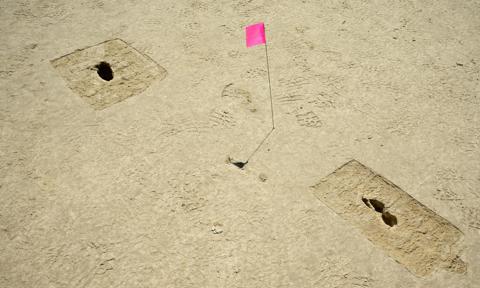
Researchers have discovered mysterious footprints in Utah, USA, called a “find of a lifetime” because of their ghostly nature. No, these tracks are not evidence of any paranormal entity but they are being described as ‘ghostly’ because they become visible only after it rains and the footprints get filled with moisture. These prints disappear again after they dry out in the sun.
READ: Archaeologists Have Discovered A 2,100-Year-Old Skeleton Lying On A Bed
MORE: Jars Retrieved From The Bottom Of The Ocean
This mind-boggling discovery happened accidentally by a group of researchers who were making their way to another nearby archaeological site at the Hill Air Force Base in Utah’s Great Salt Lake Desert.
Anya Kitterman, the cultural resource manager at Hill Air Force Base, said that they found “much more than they bargained for”.
Initially, the team only found a handful of prints but after a thorough sweep of the area using ground penetrating radar (GPR), it was revealed that there were 88 footprints in total, belonging to a range of adults and children as young as five years old.
After initial investigations, researchers suspect that the footprints belong to humans who walked on the wetlands with their bare feet about 12,000 years ago, during the final stretch of the last ice age.
READ: Mysterious Ancient Figures With Giant Heads Discovered In Tanzania
“Based on excavations of several prints, we’ve found evidence of adults with children from about 5 to 12 years of age that were leaving bare footprints,” said Dr. Daron Duke, principal investigator of Far Western Anthropological Research Group, in a statement,“People appear to have been walking in shallow water, the sand rapidly infilling their print behind them -- much as you might experience on a beach -- but under the sand was a layer of mud that kept the print intact after infilling.”

When it rains, the water is quickly absorbed deep into the surrounding sediment, which means the ground returns to its normal colour quickly. But when rain falls on these hidden footprints, the water gets trapped, creating patches of dark and wet sediment that stand out from their surroundings.
According to Duke, the most telling and surprising thing about finding these footsteps is the insight it provides into the daily life of a family group that lived in the area thousands of years ago.
A previous research group had uncovered a hunter-gatherer camp, that was about 12,000 years ago, less than 1.6 km away from where the footprints were discovered. This could be direct evidence of human settlement in the area. This is exactly what makes this discovery even more important and exciting for the researchers, says Duke.
“There is an immediate human connection to seeing human footprints. To see them from a distant past, especially so much different than it looks today, can be impactful.”
- Quick links
- history
- Archaeologists






